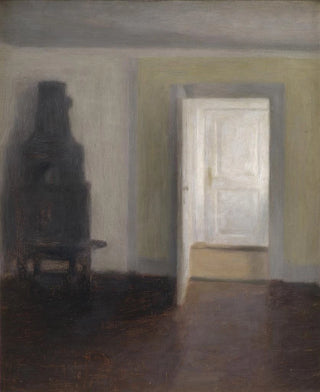Art print | Interior: An old stove - Vilhelm Hammershøi


View from behind

Frame (optional)
Interior Art print: An Old Stove - Vilhelm Hammershøi – Captivating Introduction
Vilhelm Hammershøi's artwork "Interior: An Old Stove" evokes an intimate and melancholic atmosphere, characteristic of this Danish artist's work. Painted in the early 20th century, this canvas transports the viewer into a confined space where time seems to stand still. The soft hues and delicate shadows create a serene ambiance, inviting contemplation. The old stove, a central element of the composition, becomes the silent witness to domestic life, revealing a universe where the ordinary transforms into visual poetry. This piece, both simple and complex, questions our relationship with space and light, while celebrating the fleeting beauty of everyday moments.
Style and uniqueness of the work
Hammershøi's style is distinguished by a minimalist approach and an exceptional mastery of light. In "Interior: An Old Stove," the artist plays with shades of gray and reflections, creating a play of shadows that brings the scene to life. The clean lines and carefully orchestrated composition demonstrate a particular sensitivity to interior architecture. Every element, from the old stove to the bare walls, is thoughtfully placed to evoke an atmosphere of calm and reflection. Hammershøi succeeds in capturing the essence of a moment, transforming a banal space into a scene charged with emotion. His use of perspective, combined with a restricted palette, allows viewers to feel the depth of the room and fully immerse themselves in it.
The artist and his influence
Vilhelm Hammershøi, often regarded as one of Denmark's greatest painters, made his mark by exploring themes of intimacy and solitude. His work aligns with the Symbolist movement, but he stands out for his ability to evoke deep emotions through scenes of everyday life. Hammershøi was influenced by masters such as Vermeer and Rembrandt, whose techniques of light and composition he integrated into his own practice. His unique vision not only enriched the Danish artistic landscape but also

Matte finish

View from behind

Frame (optional)
Interior Art print: An Old Stove - Vilhelm Hammershøi – Captivating Introduction
Vilhelm Hammershøi's artwork "Interior: An Old Stove" evokes an intimate and melancholic atmosphere, characteristic of this Danish artist's work. Painted in the early 20th century, this canvas transports the viewer into a confined space where time seems to stand still. The soft hues and delicate shadows create a serene ambiance, inviting contemplation. The old stove, a central element of the composition, becomes the silent witness to domestic life, revealing a universe where the ordinary transforms into visual poetry. This piece, both simple and complex, questions our relationship with space and light, while celebrating the fleeting beauty of everyday moments.
Style and uniqueness of the work
Hammershøi's style is distinguished by a minimalist approach and an exceptional mastery of light. In "Interior: An Old Stove," the artist plays with shades of gray and reflections, creating a play of shadows that brings the scene to life. The clean lines and carefully orchestrated composition demonstrate a particular sensitivity to interior architecture. Every element, from the old stove to the bare walls, is thoughtfully placed to evoke an atmosphere of calm and reflection. Hammershøi succeeds in capturing the essence of a moment, transforming a banal space into a scene charged with emotion. His use of perspective, combined with a restricted palette, allows viewers to feel the depth of the room and fully immerse themselves in it.
The artist and his influence
Vilhelm Hammershøi, often regarded as one of Denmark's greatest painters, made his mark by exploring themes of intimacy and solitude. His work aligns with the Symbolist movement, but he stands out for his ability to evoke deep emotions through scenes of everyday life. Hammershøi was influenced by masters such as Vermeer and Rembrandt, whose techniques of light and composition he integrated into his own practice. His unique vision not only enriched the Danish artistic landscape but also






